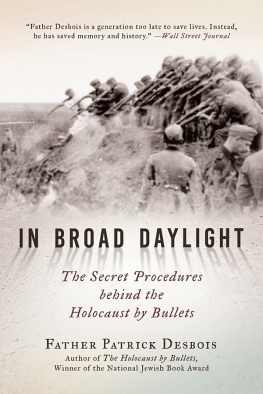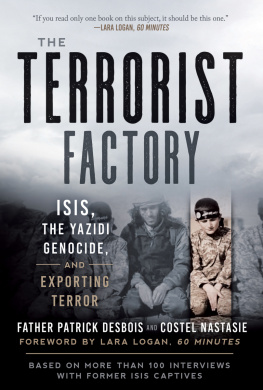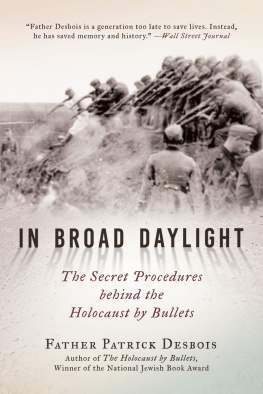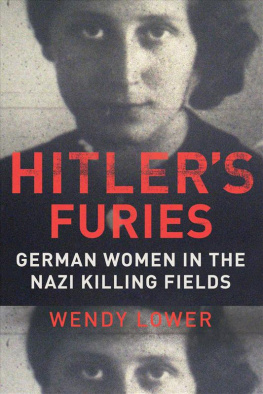Also by Father Patrick Desbois
The Holocaust by Bullets: A Priests Journey to Uncover the Truth
Behind the Murder of 1.5 Million Jews
Copyright 2015 by Librairie Arthme Fayard
English-language translation copyright 2018 by Skyhorse Publishing, Inc.
All rights reserved. No part of this book may be reproduced in any manner without the express written consent of the publisher, except in the case of brief excerpts in critical reviews or articles. All inquiries should be addressed to Arcade Publishing, 307 West 36th Street, 11th Floor, New York, NY 10018.
First Edition
Arcade Publishing books may be purchased in bulk at special discounts for sales promotion, corporate gifts, fund-raising, or educational purposes. Special editions can also be created to specifications. For details, contact the Special Sales Department, Arcade Publishing, 307 West 36th Street, 11th Floor, New York, NY 10018 or arcade@skyhorsepublishing.com.
Arcade Publishing is a registered trademark of Skyhorse Publishing, Inc., a Delaware corporation.
Visit our website at www.arcadepub.com.
Visit the authors website at www.yahadinunum.org.
The views or opinions expressed in this book, and the context in which the images are used, do not necessarily reflect the views or policy of, nor imply approval or endorsement by, the United States Holocaust Memorial Museum.
10 9 8 7 6 5 4 3 2 1
Library of Congress Cataloging-in-Publication Data
Names: Desbois, Patrick, author. | Reyl, Hilary, translator. | Barksdale, Calvert, translator.
Title: In broad daylight : the secret procedures behind the Holocaust by bullets / Father Patrick Desbois ; translated from the French by Hilary Reyl and Calvert Barksdale.
Other titles: Voisins du crime. English
Description: First edition. | New York : Arcade Publishing, [2018]
Identifiers: LCCN 2017041541 (print) | LCCN 2017043328 (ebook) | ISBN 9781628728590 (ebook) | ISBN 9781628728576 (hardcover : alk. paper)
Subjects: LCSH: JewsPersecutionsSoviet Union. | Holocaust, Jewish (19391945)Soviet UnionPersonal narratives. | Soviet UnionEthnic relations.
Classification: LCC DS134.85 (ebook) | LCC DS134.85 .D4713 2018 (print) | DDC 940.53/180922477dc23
LC record available at https://lccn.loc.gov/2017041541
Cover design by Erin Seaward-Hiatt
Cover photo Imperial War Museum (HU86369)
Printed in the United States of America
CONTENTS
HISTORICAL INTRODUCTION
S EPTEMBER 1941: Eight hundred Jews are shot by a German unit in Pushkin, near Saint Petersburg, in Russia.
O CTOBER 12, 1941: Three hundred Jewish women and children are executed by German customs officials and Lithuanian police in Palanga, Lithuania.
T HE END OF 1941: Dozens of Jewish families are killed by a German unit in Naro-Fominsk, forty miles from Moscow.
D ECEMBER in Naltchik, in the Balkan republic of Kabardino in southern Russia, forty miles from Georgia.
T hese four mass killings during World War II are geographically linked. They mark the farthest reaches of the Shoah by bullets that was perpetrated by German units in Soviet territory.
Between 1941 and 1944, thousands of executions took place in the Soviet republics of Russia, Ukraine, Belarus, Moldavia, Estonia, Latvia, and Lithuania, over an area ranging from Galicia to the shores of the Baltic Sea and from the Muscovite forests to the Caucasian borders.
village or tens of thousands of people in a large Ukrainian city.
From the summer of 1941 through the spring of 1944, the killers repeated the same process over and over: the exterminating the Jewish populationmen, women, and childrenby firing squad, most often at sites just outside villages and towns. Despite concerns by the Nazis in charge about the psychological health of the executioners, no alternative method was put in place.
Paul Blobel, the head of Sonderkommando 4a, the main unit responsible for the September 1941 massacre of the Jews of Kiev in the Babi Yar ravine,:
B LOBEL : Everything went very quietly. It took time, of course, and I must say that our men who took part in these executions suffered more from nervous exhaustion than those who had to be shot.
M USMANNO : In other words, your pity was more for the men who had to shoot than for the victims?
B LOBEL : Our men had to be cared for.
M USMANNO : And you felt very sorry for them?
B LOBEL : Yes. These people suffered a lot, psychologically.
smoothly carried out. Such was the case of Waffen-SS Herbert Wollenweber, a member of Sonderkommando 10a. When questioned about a major execution of Jews in the foothills of the Caucuses, he chose to emphasize his commandos expertise.
The Jews were fairly calm. Schmitt [the leader of the commando] had organized
The members of the death squads accepted the Shoah by bullets as the only efficient method of extermination over such vast territory (almost one million square miles). Franz Halle, a member of the police and Sonderkommando 4a, explained his attitude regarding the extermination of the Jews in Ukraine when he was questioned about the Sonderkommando s actions in a hearing:
Today, I admit that these proceedings were very misguided. At the point we had reached, we should have found other methods of exterminating the Jews.
Halle betrayed no guilt about killing Jews, nor did he question the nature of the orders he received. For him, only the method to be used in committing murder posed a problem. The murder itself was simply a task to be carried out.
There is a second major difference between the Shoah in the East and the murder of the Jews in concentration and extermination camps, such as Operation Reinhardt. The deportation of Jews to these camps was often done in secret or at least discreetly. Sometimes, in the case of those headed to Auschwitz, the victims were forced to write to their relatives to say that all was well and not to worry.
The Shoah in the East, by contrast, was not discreet. The victims were publicly assembled, albeit often at first on the pretext of being sent to a labor camp or to Palestine. The mass murder then took place in full view of the victims neighbors, the curious, and soldiers or civilians who happened to be there. The following testimony from a German staff sergeant named Snnecken, a member of the appears in a report on the execution of several thousand Jews of Borisov, shot in Belarus in October 1941:
In the distance the noise of rifles could be heard all day, the women and children cried and screamed, cars sped through the streets of the ghetto, bringing new victimsall in full view of the civilian population and any German military personnel who happened to be passing by.
Maintaining secrecy would have been all the more difficult given that the local population was regularly conscripted to assist before, during, and after the shootings. Sometimes the executioners forced the townspeople to watch the killings; sometimes it was passersby, stopped to ensure that they didnt get in the way, who witnessed the murders. The presence of spectators, whether forced or voluntary, wasnt a concern, so long as it didnt disrupt the efficiency of the operation.
It may seem surprising, then, that this aspect of the archives.
Toward the end of 1942, the Soviets created the Extraordinary State Commission Virtually inaccessible to Western historians before the fall of the Berlin Wall, this material is now available in the Russian Federal Archives.








